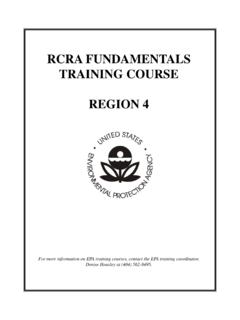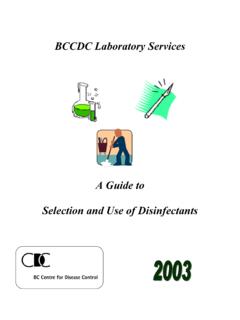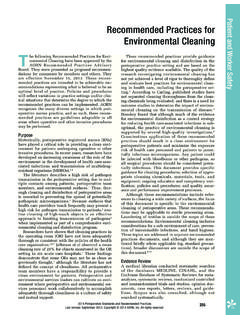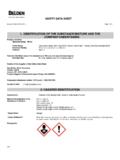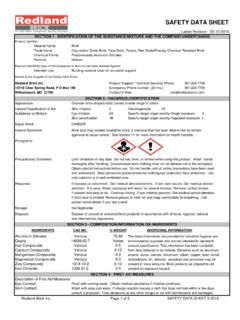Transcription of 40 Hour HAZWOPER – Equipment List - ERTPVU
1 40 hour hazwoper equipment list Purpose: This document outlines the equipments and supplies needed for a 40- hour HAZWOPER course. Numbers and types of Equipment may vary relative to the number of students. Equipment substitutions may be made as necessary to accommodate special-student requirements. Administrative: Computer with course modules loaded and/or DVDs LCD/LED Projector Sound system, at least 10 Watts Surge-arrestor-multi-outlet power strip and extension cords Student Manuals Course paperwork; student registration card, 40- hour daily sign in sheet, agenda, Course Evaluation, chemical characteristic homework, air monitoring lab worksheet and ERG Exercise Instructor packet Information resource materials (SDSs, NIOSH Pocket Guides, ERGs, WISER, etc.)
2 Flip Chart or White erase board -- Dry erase markers and erasers Permanent markers- Broad and narrow tip Air Monitoring Lab Practical: Sample chemicals (acid, base, solvents, pesticides, etc.) Sample jars Pipettes (disposable) Absorbent pads Paper towels Colorimetric pumps and tubes Multi-gas meters (CGI, PID, oxygen, carbon monoxide, etc) Additional gas meters (FID, portable GCMS, nerve agent detectors, etc) Radiation meters Litmus (pH) paper Water-finding paper Chemical reagents Tedlar bags for gas samples Bump Gas/Calibration Gas (below is recommended, but should acquire calibration gas specified for particular instruments used)
3 -Methane by volume in air to give a 50% reading on the LEL sensor - Hydrogen Sulfide 25 ppm for H2S sensor -Carbon Monoxide 100 ppm for CO sensor -Oxygen 18% for O2 sensor -Nitrogen should be the balance or remainder of the composite cal gas cylinder. -Isobutylene 100 ppm for any PID ultra violet sensor with % Oxygen in Nitrogen balance. Eye protection Disposable Gloves 40 hour hazwoper equipment list Personal Protective Equipment : Level A suits (one per student, cleaned and disinfected after each class suit selection should range in size from Small through 2X) Level B/C suits (one hooded chemical resistant disposable suit per student, sizes from Small through 5X) Self Contained Breathing Apparatus (SCBA) backpacks, also known as SCBA racks Masks compatible with SCBA backpacks (note if possible use masks that can convert from Supplied Atmosphere -tank or airline- to an Air Purifying Respirator using an adapter such as a T-bar ).
4 SCBA tanks that have the proper/legal hydrostatic test label with approved Grade D breathing air. Disposable gloves Duct tape (one roll per two students minimum) Chemical Resistant Tape (show and tell only) Chemical Resistant boots Chemical Resistant outer gloves Dress out chairs, stools, step stool or other furniture for students to sit down while dressing out. Mask disinfectant wipes (use manufactures recommended disinfectant as some disinfectants may not be compatible and will cause material degradation that will shorten Equipment s useful life) Entry Equipment Analysis Equipment (gas-detection instruments, detection papers, etc.)
5 Mitigation Equipment (absorbent booms, pads, etc) Tape Tools for entry (non-spark producing bung wrench, screw drivers, hammer; plugs, shims, pipe clamps, spill Equipment , etc.) Clip boards, pens, dry markers Decontamination Equipment Rinse-solution collection pools (kids wading/swimming pools work well for training) Tarps Brushes and sponges with 5 gallon plastic buckets to hold when not in use. Step ladders (two step to be used as a stool for dressing out) Walkers (to prevent slips, trips and falls when going into or out of a pool) Absorbent mats Garden-type hoses, depending on distance to water supply.
6 Pump sprayers Signs 40 hour hazwoper equipment list Cones and caution tape Victim rescue Equipment (stretcher, sled, etc.) Drums Chairs Plastic bags for sample decontamination Scenario Equipment Nuts/bolts/wing nuts (dexterity training) Dexterity games and Equipment (tennis balls, footballs, Frisbees, etc) Drums Pipes Chemical labels Binoculars Radios Clipboards Incident Command System position vests Sample chemicals for scenario and labs (acids, bases, solvents, flammables, etc) Chemical labels and waste marks Placards and NFPA Diamonds Storm-Drain simulator, stuffed/rubber-animals and other visual aids Shaving cream and baby powder (contaminants)
7 Bullhorn Support Equipment Tools for repairs Extra batteries for Equipment ( AA, AAA, C, D etc) Plastic bags (1 quart and 1 gallon Ziploc work well) Scissors Knifes Zip-type cable ties Permanent markers
